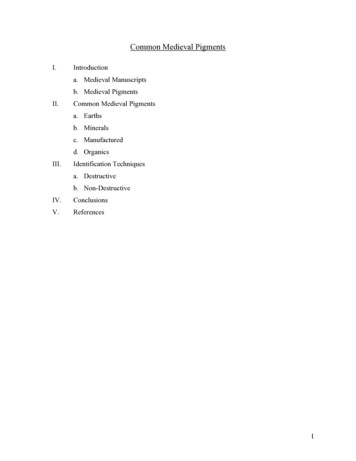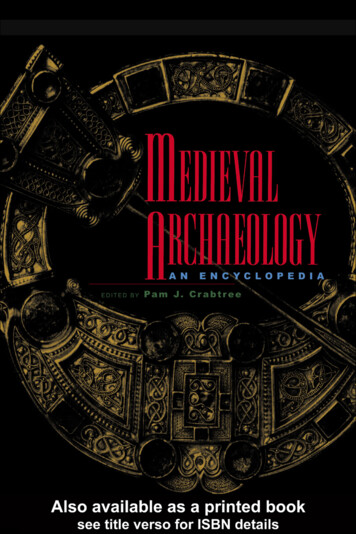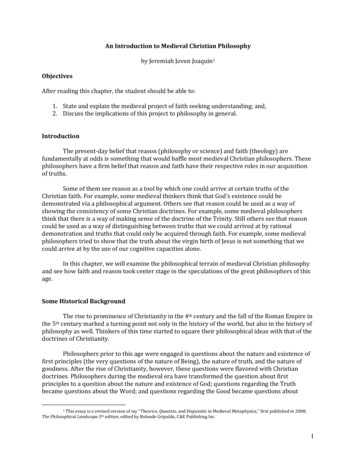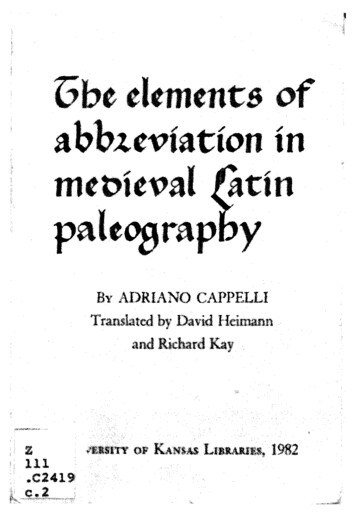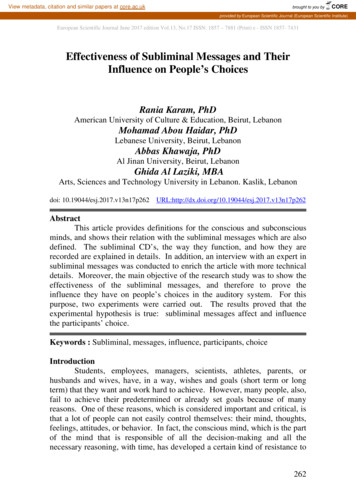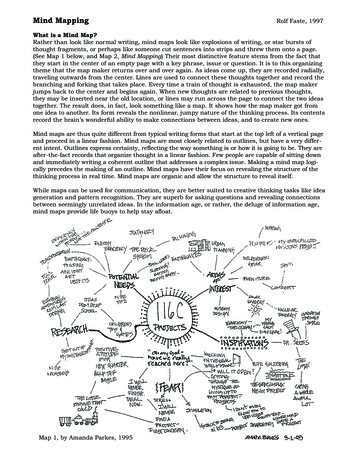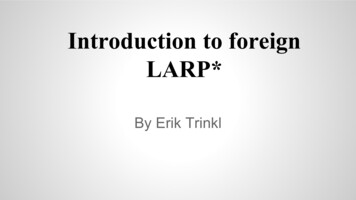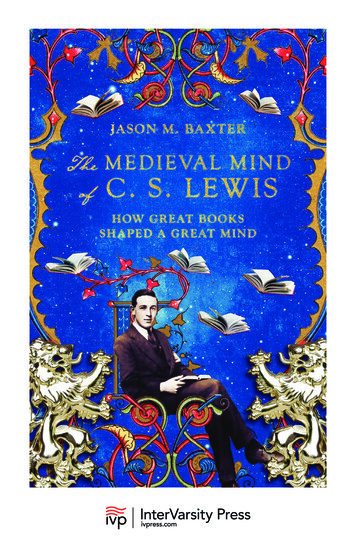
Transcription
Taken from The Medieval Mind of C. S. Lewis by Jason M.Baxter.Copyright 2022 by Jason Michael Baxter.Published by InterVarsity Press, Downers Grove, IL. www.ivpress.com.
CHAPTER ONEThe L OS TC AT H EDRA LThe Medieval CosmosCharacteristically, medieval man . . . was an organizer, a codifier,a man of system. His ideal could not be unfairly summed up . . .“a place for everything, and everything in its (right) place.” Threethings are typical of him. First, that small minority of his cathedralsin which the design of the architect was actually achieved. . . . I amthinking of a thing like Salisbury. Secondly, the Summa of ThomasAquinas. And thirdly, the Divine Comedy of Dante. In all these alikewe see the tranquil, indefatigable, exultant energy of a passionatelylogical mind ordering a huge mass of heterogenous details into unity.They desire unity and proportion, all the classical virtues, just askeenly as the Greeks did. But they have a greater and more variedcollection of things to fit in.C . S. L ew i s , “Im ag i nat ion a n d Thou g ht in t he Middl e Ag es,”Stu dı e s ı n Me dı eva l a n d R e na ı s s a nce L ı t e r at u reIn the popular imagination , as Lewis joked more than once,the term “Middle Ages” evokes a misty blend of knights, castles,witch trials, torture devices, armor, superstitious peasants (coveredin dirt), and maybe a dragon and princess thrown in to boot. Need it375337NEF MEDEVIAL CC2019 PC.indd 1908/12/2021 15:27:36
20THE MEDIEVAL MIND OF C . S. LEWISbe said? That was not how Lewis envisioned the time period. Rather,as he pointed out in all of his academic writing, the medieval periodwas not an age of primitive superstition, but one of bookish sophistication (see epigraph), and anyone who has wandered around a great,Old World cathedral, like Salisbury Cathedral, has some idea of whatLewis’s comparison means: it is a paradoxical juxtaposition of astonishing variety, meticulous order, and a saturation of light. On the onehand, both modern and medieval visitors are dazed by the height ofthe vault, the forest of ordered columns, the infinite variety of decorative motifs and side chapels and stones, while being impressed, atthe same time, by the radiation of color, as if light were dwelling inliving stones. In a phrase, this is what Lewis meant by “finely orderedmultiplicity.”1 But in addition to these structures of literary, logical,and architectural order—the Comedy, Summa, and Salisbury Cathedral—Lewis wanted to include one more work of art as “typical”of the medieval achievement: the “medieval synthesis itself, thewhole organisation of their theology, science, and history into asingle, complex, harmonious mental Model of the Universe.”2 Inother words, what Lewis admired most was not simply this or thatmedieval belief or doctrine, but rather the whole way of viewing theworld, the whole ensemble, the whole intellectual “atmosphere” ofwhat I have called the Long Middle Ages, and it was that which he, asthe modern Boethius, felt it was vital to preserve, explain, and makeintelligible, even within modernity. In short, Lewis perceived that forthe medieval period, the natural world, like so many stained-glasswindows, was, as it were, transparent to a light from beyond thisworld. What are for us merely natural processes seemed to our ancestors phenomena that pointed beyond themselves. The wholeworld felt like a cosmic cathedral.This chapter will build on the previous one by explaining what itwas exactly that Lewis saw and felt in the medieval period that1 I, 11‑12. For more on this, consult Bissera Pentcheva’s excellent “Hagia Sophia and MulDtisensory Aesthetic,” Gesta 50, no. 2 (2011): 93‑115.2 DI, 11.375337NEF MEDEVIAL CC2019 PC.indd 20 08/12/2021 15:27:36
The Lost Cathedral21justified the intensity of his lifelong devotion to the study and “translation” of ideas and texts from the medieval period into the modernvernacular. And what we’ll see is that this ensemble of beliefs thatmade up the medieval “model”—Lewis’s term for the cosmic ima ginary of the medieval period—was not only a kind of work of art, but,more importantly, an image, a powerful thought experiment, a kindof icon.It was this medieval view of the universe that became the root metaphor for his “doctrine” of transposition. In one of his greatest sermons,Lewis develops a musical metaphor, “transposition,” to refer to thosevarious moments when a higher, more complicated system is e xpressedin a lower, less complicated one—for example, when a Mahler symphony, with its gargantuan orchestration for four hundred instruments, is transposed for a piano, or when a language with a huge vocabulary is translated into one with a limited one (like Latin intoAnglo-Saxon). This happens, too, in our emotional lives. In the sermon,Lewis reflects on a passage from Samuel Pepys’s diary, in which theseventeenth-century author, in an effort to describe the delight andrapture he experienced at a concert, compared that aesthetic experience to the jittery nerves he had suffered when he first fell in lovewith his wife, as well as to the jittery nerves he experienced whenseasick! The bodily experience of falling in love, the fluttering of thediaphragm that we experience when in love, the rapturous shortnessof breath we experience when we listen to Elgar’s Cello Concerto, orthe queasy fluttering of the diaphragm we suffer when we are sick atsea are all, on the mere physiological level, impossible to distinguish.3But if we believe that the emotional life is higher, more varied, andmore subtle than the life of bodily needs and sensations, it follows thatwe encounter the bodily language’s “limited vocabulary” when the lifeof the mind and heart overflow into our physical sensations.4 Lewisdevelops this thought experiment of transposition in order to3 . S. Lewis, “Transposition,” in The Weight of Glory: And Other Addresses (New York:CHarperOne, 1980), 95-97.4 Lewis, “Transposition,” 99.375337NEF MEDEVIAL CC2019 PC.indd 21 08/12/2021 15:27:36
22THE MEDIEVAL MIND OF C . S. LEWISconstruct an explanatory model for how higher spiritual realities arerelated to lower sensible realities. As my emotions are to my physicalsensations, so too is the “higher world” to the natural world of timeand nature: it fills this world and makes it seem “too full,” “too dense”to not point beyond itself.This, then, is what is at stake when considering Lewis’s admirationfor medieval cosmology, because for him the medieval universe wasnot just a system of exploded scientific beliefs, but the natural, icon oftransposition, the greatest example of the spiritual world expressingitself in the limited vocabulary of the physical, natural world. Andwhat nuclear reactors, particle accelerators, and the Hubble telescopeare for us, the medieval cathedral—and the cosmological “model” itrepresented—was for the medieval period: a kind of “experiment” thatmade visible an elusive and deeper truth. It is this iconic vision of themedieval cosmos that Lewis tried to get his students and audiences tosee, and feel, and breathe. Thus the Oxford professor’s interest in medieval cosmology was not merely an arcane, archaeological antiquarianism. Why? Because being able to see the world with medieval eyescould provide even modern people with a “model” for thinking aboutthe relationship between the natural and spiritual world.I’ll now try to provide a sketch of what that medieval vision was bydrawing from Lewis’s favorite medieval authorities.A Snapshot of the Medieval CosmosToday, if we read the ancient statesman and author Cicero at all, it isbecause we think of him as a great exemplar of ancient republicanpolitics, as the orator who defended the republic from tyranny bymeans of the elegant word. In the Middle Ages, though, Cicero’s famewas due to a short, visionary treatise, the “Dream of Scipio,” a ten-pageaccount of a Roman general’s prophetic dream that served as the concluding chapter to his own attempt to respond to Plato in his ownLatin-speaking Republic. In the medieval period, the pages that makeup this visionary dream tale were copied out independently from therest of the text, in part because a writer, several centuries later in late375337NEF MEDEVIAL CC2019 PC.indd 22 08/12/2021 15:27:36
23The Lost Cathedralantiquity, Macrobius—whose writing is analyzed by Lewis in Dis‑carded Image5—had made it famous by devoting a three hundredpage commentary to it. Macrobius, a Latin-writing Platonist, wasworking sometime in the early 400s AD, and he was convinced thatevery word in Cicero’s visionary account had a deep, mystical significance. This belief conditioned the next thousand years to read Cicero’s“Dream of Scipio” in hushed, reverent tones, as if, within these pages,the deep mysteries of the universe were revealed to those with eyes tosee. Lewis knew these texts intimately.In Cicero’s imaginative account Scipio floats up through the spheresof the heavens and comes to stand at the apex of the universe in orderto take in a “view from above.” Once there, Scipio (like Dante over amillennium later) is warmly greeted by his male ancestors, who givehim lessons in the Roman virtues of honor, justice, and duty. They alsomake him turn around to contemplate the universe stretched out beneath his feet. At one particularly dramatic moment, Scipio looksdown and sees the cosmos moving beneath his feet, and then, hearingan incredible music, he asks, “What is this sound, so loud and yet sosweet, that fills my ears?” His guide answers,That is the sound produced by the impetus and momentum ofthe spheres themselves. It is made up of intervals which, thoughunequal, are determined systematically by fixed proportions.The blend of high and low notes produces an even flow of variousharmonies. . . . By imitating this system with strings and voicesexperts have succeeded in opening a way back to this place. . . .Filled with this sound, people’s ears have become deaf to it.6In other words, the planets are spaced out proportionally to one another,so that the distances between Earth and Mars, and Venus and Jupiter, correspond to harmonic intervals of chords. As the planets rotate, they createa kind of intellectual music, to which we earthlings have become deaf, but56 I, 60‑69.D Cicero, The Republic and the Laws, trans. Niall Rudd, Oxford World’s Classics (Oxford:Oxford University Press, 1998), 90.375337NEF MEDEVIAL CC2019 PC.indd 23 08/12/2021 15:27:36
24THE MEDIEVAL MIND OF C . S. LEWISwe can regain the ability to hear this music through study or throughbeautiful music, which imitates the same harmonic proportions.This idea of a musical universe—whose planets are spaced out likestrings on a musical instrument—delighted the imaginations of medievalthinkers. Boethius, to take one example, borrowed this idea from Cicero.In a particularly beautiful poem in his Consolation of Philosophy, Boethius, too, imagines himself high above our universe, viewing the cosmosstretched out beneath his feet. You can hear the author’s excitement anddelight as he describes the choreographed movements of the universe:Starmaker, master of spheres,At whose command the heavens spinIn the constellations’ dance that youOn your steady throne have choreographed,Bright stars grow dim as you bring on the moon,Crescent or gibbous, reflecting her brother’sDazzling fire. . . .When leaves fall and the cold of winterBlows from the north, our days diminish,But then, in summer’s burgeoning heatThe dark hours of nighttime dwindle. . . .Not even the blowing winds are random,But Boreas strips leaves from the treesAnd Zephyrus brings on gentling nurture.7“Not even the blowing winds are random,” says Boethius rhapsodically.In other words, Boethius closed his eyes, looked at the earth in hismind’s eye, watched its seasons springing up and falling away, andperceived the heavens rotating, all in ordered rhythms. This is what7 Boethius, Consolation of Philosophy 1.5 (18‑19). For Boethius’s Latin, I use De ConsolationePhilosophiae, ed. Claudio Moreschini (Berlin: de Gruyter, 2005). For Boethius’s poetry, Ilike Consolation of Philosophy, trans. David Slavitt (Cambridge, MA: Harvard UniversityPress, 2008), on account of its lyrical quality. (The translation quoted here is Slavitt’s.) Butfor the prose I prefer the literalism of the old Loeb volume: Theological Tractates, TheConsolation of Philosophy, trans. H. F. Stewart, E. K. Rand, and S. J. Tester, Loeb ClassicalLibrary 74 (Cambridge, MA: Harvard University Press, 1973).375337NEF MEDEVIAL CC2019 PC.indd 24 08/12/2021 15:27:36
The Lost Cathedral25Boethius, in his lesser-known work De musica, called “the music of thecosmos.” For Boethius, as for Cicero, there is a rational order thatkeeps the world in balance, keeping it from spinning out of control. Itensures that elements of different kinds bond properly to one another;it regulates how the seasons cycle in an ongoing carousel; this orderalso regulates how the stars and planets turn. He calls this cosmicorder “music” because it is a deep, mathematical harmony that framesout the world in understandable patterns. What is more, Boethius(again like Cicero) taught that through instrumental music we canregain a “taste” of the musicality of the world, and thus retune oursouls to cosmic music. Music is philosophical therapy, bringing thesoul back into tune with the great Conductor’s universe. This is whythe Consolation of Philosophy alternates between prose and verse.8In a 1956 lecture to the Zoological Laboratory in Cambridge, wefind Lewis not only giving a précis of his Discarded Image but alsotrying to “perform” the sound of this symphonic cosmos. In the lecture,he asks his audience of modern scientists to conduct a thought experiment: “Go out on any starry night and walk alone for half anhour, resolutely assuming that the pre-Copernican astronomy is true.Look up at the sky with the assumption in your mind.”9 And if you doso, you will be able to catch a glimpse of how the old universe at once“abashes and exalts the mind,”10 in contrast to the modern conceptionof the world, which imposes on the mind a sense of being lost in infinite and vast space. He explains that if we look up into the sky withmedieval expectations in mind, then we will feel it both as finite (“hard,clear, sudden as a national frontier”11) but also as pushing down on us(“because the Earth is an absolute center, and Earthwards from anypart of this immense universe is downwards, you will find that you are8 David Chamberlain, “Philosophy of Music in the Consolatio of Boethius,” Speculum 45,no. 1 (1970): 80‑97; Stephen Blackwood, The Consolation of Boethius as Poetic Liturgy(Oxford: Oxford University Press, 2015).9 Lewis, “Imagination and Thought,” in Studies in Medieval and Renaissance Literature,Canto Classics (Cambridge: Cambridge University Press, 1998), 47.10 Lewis, “Imagination and Thought,” 48.11 Lewis, “Imagination and Thought,” 48.375337NEF MEDEVIAL CC2019 PC.indd 25 08/12/2021 15:27:36
26THE MEDIEVAL MIND OF C . S. LEWISlooking at the planets and stars in terms not merely of ‘distance’ but ofthe very special kind of distance which we call ‘height’”12):These two factors taken together—enormous but finite size, anddistance which, however vast, remain unambiguously vertical,and indeed vertiginous—at once present you with somethingwhich differs from the Newtonian picture rather as a greatbuilding differs from a great jungle. You can lose yourself in infinity; there is indeed nothing much else you can do with it. Itarouses questions, it prompts to a certain kind of wonder andreverie, usually a somber kind. . . . But it answers no questions.13In addition to Macrobius, Lewis also believed that another authorwas foundational for the medieval model: Calcidius, who wrote, atsome point in late antiquity, a massively tedious but extremely successful commentary on Plato’s Timaeus, the only work of Plato to beread throughout the medieval period. Calcidius crawls passage bypassage through Plato’s text, dividing the text up into blocks andtaking the occasion to provide what he thought would be the necessarybackground for each subject.14 In this way, Calcidius, who never saysno to a digression, provides a manualistic introduction to any field ofmedieval science you could hope to know about. He was so digressivethat, four hundred pages after he started, he had only made it halfwaythrough the Platonic text he wished to comment on.But what is a bizarre and tiresome book for us was a treasure formedieval students and scholars. On more than one occasion we findCalcidius a little breathless before his vision. When he looked up at theheavens, he saw “a perfect, unchanging symphony” because the stars“are borne round in a unified and constant movement, adhering to the[the largest sphere which embraces all things] as it leads them round,always maintaining one and the same position and preserving theirorder in an unvarying pattern, never admitting any change in position,12 ewis, “Imagination and Thought,” 48.L Lewis, “Imagination and Thought,” 48.14 Calcidius, On Plato’s Timaeus, ed. John Magee, Dumbarton Oaks Medieval Library(Cambridge, MA: Harvard University Press, 2014).13375337NEF MEDEVIAL CC2019 PC.indd 26 08/12/2021 15:27:36
The Lost Cathedral27ascent, size, or even color.”15 But when he lets his ecstatic eyes driftback down to everything below the moon, like some medieval anticipation of Cormac McCarthy, he is disgusted. This is the realm of “birthand death” and “increase and diminution, every kind of transformation, and transposition form place to place” where “murder, violence, madness” dwell.16 Lewis poignantly described this medievalattitude by likening the state of human beings to those who watch thecelestial spectacle from afar, from the outskirts. Watching its beauty,we are overwhelmed, and desire to imitate it to the extent we can. Weare, in a word, “anthropoperipheral”: “We are creatures of the Margin.”17Over his lengthy commentary, Calcidius builds up a picture of theworld in his reader’s mind: the movement of stars and planets, the interaction of elements, the whole moving picture of the world. But thegenius of the vision is found in how all of these movements participatein the same underlying pattern, the deep music or mathematicalharmony that rules the world. For Calcidius, “mathematics” is morereal than the visible, because it is the rational design of which everything else is merely a physical expression. By perceiving this deep levelof numbers, we can discover the mathematical skeleton beneath theworld’s skin, and so can get at the “real” world, the deep world. We’renow beginning to see why the metaphor of cathedral is pertinent tomedieval cosmology. For Calcidius, and the rest of the tradition, if youcultivate a perception of the deep harmony of nature, it leads to worship,because the “soul, fashioned after the same pattern as the celestialbodies, immediately recognizes its own natural affinity to them.”18 Inother words, despite the messiness of earthly reality, we find underneath the material a paradigm of order, and thus we can see that, in anextraordinary phrase, “time is an image of eternity.”19 Even more significantly, these harmonic patterns are likened to the longing and groansof a world that is earnestly engaged in making itself as like the eternal15 Calcidius, On Plato’s Timaeus, 231. Calcidius, On Plato’s Timaeus, 243.17 DI, 58.18 Calcidius, On Plato’s Timaeus, 211.19 Calcidius, On Plato’s Timaeus, 157; repeated in Boethius.16375337NEF MEDEVIAL CC2019 PC.indd 27 08/12/2021 15:27:36
28THE MEDIEVAL MIND OF C . S. LEWISsimplicity of the divine as it can. Eternity is the world’s “paradigm” (itsexemplar, goal, and end), and that end is invisible and full of joy, therealm of “pure intelligible light.” For this reason, the visible world, inPlato’s phrase, is a great “icon”: it is an artistic representation that translates into a new medium the eternal principles of a higher order. Thevery physical movements of the world constitute a kind of longing tomeasure up. Physics is prayer in an iconic universe.20 Thus the universeis a kind of text, which inspires contemplation of the deep patterns builtin by the craftsman.21 All of these orchestrated motions exist becausethey constitute the best possible way to make manifest the perfectionof eternity.22 And when we grasp this point, we have come to the heartof the “iconic” nature of the model Lewis so admired. It is a difficultconcept—time’s imitation of eternity—but Lewis thought it was fundamental to the understanding of the medieval world.For instance, in Discarded Image, Lewis provides a brilliant synthesisof some of the most severely dialectical arguments that make up Conso‑lation V, the final chapter of Boethius’s magnum opus, that part specifically concerned with the relationship between perpetuity and eternity.Although most of us think of “eternity” as that which goes “on and on,”Boethius explains, we should actually call that, “perpetuity.” Perpetuityis nothing more than an endless chain of brief moments, connectedtogether. And given that eternity, on the other hand, is the “actual andtimeless fruition of illimitable life,” Boethius can call time an imitationof eternity. Time, as it were, is almost a “parody” of eternity, a “hopelessattempt to compensate for the transitoriness of its ‘presents’ by infinitelymultiplying them.”23 God, of course, is not perpetual, but eternal. Andso, what, in time, is spread out over an infinite number of moments, canbe found gathered into a full and simultaneous perfection in God.In other words, the world of time itself is a veil, behind whichstands eternity, and Lewis was not reticent about his admiration of20 See Plato, Timaeus 27c. Calcidius, On Plato’s Timaeus, 318.22 Calcidius, On Plato’s Timaeus, 243.23 DI, 89.21375337NEF MEDEVIAL CC2019 PC.indd 28 08/12/2021 15:27:36
29The Lost Cathedralthis passage in Boethius. In fact, Lewis thought that Boethius haddone a better job than Plato himself in explaining how the invisibleand visible worlds are connected!24But this was not the first time Lewis attempted to expound theancient idea of time imitating eternity. Decades earlier, in a long butimportant passage from his 1936 Allegory of Love, he used the synonymous terms symbolism and sacramentalism to get at this Platonictradition transmitted to the medieval period by Calcidius and Macrobius. Appreciating the world’s symbolism must begin, the scholarnotes, with observing the crucial difference between “sacramentalism”and mere “allegory”:If our passions, being immaterial, can be copied by material inventions [through allegory], then it is possible that our material worldin its turn is the copy of an invisible world. As the god Amor andhis figurative garden are to the actual passions of men, so perhapswe ourselves and our “real” world are to something else. The attempt to read that something else through its sensible imitations,to see the archetype in the copy, is what I mean by symbolism orsacramentalism. . . . To put the difference in another way, for thesymbolist it is we who are the allegory. . . . The world which wemistake for reality is the flat outline of that which elsewhere veritably is in all the round of its unimaginable dimensions. . . .Symbolism comes to us from Greece. It makes its first effectiveappearance in European thought with the dialogues of Plato. TheSun is the copy of the Good. Time is a moving image of eternity.All visible things exist just in so far as they succeed in imitatingthe Forms. . . . [This is the] diffused Platonism, or Neoplatonism—if there is a difference—of Augustine, the pseudo-Dionysius, ofMacrobius, of the divine popularizer Boethius.25The whole world, then, can be read as a “symbol”—that is, a “copy,” asin a mirror that distorts an image or a portrait that merely sums up a2425 I, 89‑90.D C. S. Lewis, The Allegory of Love (Oxford: Oxford University Press, 1958), 45‑46.375337NEF MEDEVIAL CC2019 PC.indd 29 08/12/2021 15:27:36
30THE MEDIEVAL MIND OF C . S. LEWISlikeness. When dealing with our earthly “images” or “copies” or “depictions,” we know that the real thing is better: because it is alive, inmotion, has color and depth. And so, we must apply this to the cosmos.It is copy. In a strange way, even the fundamental properties of physics(motion and space and time) are mere images, pointing to some morefundamental reality. This is what Chris Armstrong has called Lewis’s“world-sacramentalism.”26Symphony of the WorldBut as I have already suggested, the major contention of this book is thatwe always have to keep in mind the “third Lewis,” that is, the vernacularizer or popularizer who translated these abstract formulations oftime’s imitation of eternity into devotional and imaginative writings.And so, I would like to conclude this chapter with two quick examplesto show how the new, British Boethius used his fiction to re-create (in amodern vernacular) what it felt like to “breathe” this medieval air.In the creation scene found in The Magician’s Nephew, Diggory andJill, along with Uncle Andrew, the White Witch, and the cabby, are castinto Narnia before the world had been made. Standing there in the precosmic dark, when Narnia was yet formless and void, the ragtag groupis able to watch as creation is sung into existence. At first, Diggory hearslow notes “deep enough to be the voice of the earth herself.”27 It is “themost beautiful noise he had ever heard. It was so beautiful he couldhardly bear it. The horse seemed to like it too; he gave a sort of whinnya horse would give if, after years of being a cab-horse, it found itselfback in the old field where it had played as a foal.”28 But then somethingmore wondrous takes place: that single melodic line becomes a richtapestry of multiple melodies. It becomes a kind of medieval polyphony.The initial line is joined by “more voices than you could possibly count.They were in harmony with it, but far higher up the scale: cold, tingling,26S ee his discussion of how medieval “sacramentality” can serve as a rejoinder to modernmaterialism in Medieval Wisdom, 147‑64.27 C. S. Lewis, The Magician’s Nephew (New York: HarperTrophy, 1984), 116.28 Lewis, Magician’s Nephew, 116.375337NEF MEDEVIAL CC2019 PC.indd 30 08/12/2021 15:27:36
The Lost Cathedral31silvery voices.”29 These are the voices of the stars joining the symphony.Soon, “the Voice on the earth was now louder and more triumphant,”30as it sung the sun into being: “The eastern sky changed from white topink and from pink to gold. The Voice rose and rose, till all the air wasshaking with it. And just as it swelled to the mightiest and most glorious sound it had yet produced, the sun arose,”31 and “you couldimagine that it laughed for joy as it came up.”32 The song changes onemore time: “The Lion was pacing to and fro about that empty land andsinging his new song. It was softer and more lilting than the song bywhich he had called up the stars and the sun; a gentle, rippling music.And as he walked and sang the valley grew green with grass.”33 Pollynotices that “when you listened to his song you heard the things hewas making up: when you looked round you, you saw them. This wasso exciting that she had no time to be afraid.”34 In this Mahler-likesymphonic moment (I’m thinking especially of Symphony no. 1), Aslanhas not only sung the earth, the stars, the sun, the flowers, and theanimals into existence, but also let his song infuse his creatures, so thathis song has become their song. The stars, the sun, the plants, the animals have their own personalities, but as lent to them by Aslan. Theworld is penetrated by song, and joy. It is a polyphonic world of beautythat leaves you “with open mouths and shining eyes.”35In a second passage, his brilliantly terrifying séance in “The Descentof the Gods,” in That Hideous Strength, Ransom and Merlin are visitedby the ancient planetary intelligences—that is, the pure, spiritual intellects of classical mythology descend, drawing all the affairs of thehousehold into their spiritual fields. When the winged Mercury comesto visit, the household erupts in uproarious talk, outrageous banter, punsand jokes and arguments of ridiculous complexity: “Paradoxes, fancies,29 Lewis, Magician’s Nephew, 116‑17. Lewis, Magician’s Nephew, 117.31 Lewis, Magician’s Nephew, 119.32 Lewis, Magician’s Nephew, 119.33 Lewis, Magician’s Nephew, 123.34 Lewis, Magician’s Nephew, 126‑27.35 Lewis, Magician’s Nephew, 118.30375337NEF MEDEVIAL CC2019 PC.indd 31 08/12/2021 15:27:36
32THE MEDIEVAL MIND OF C . S. LEWISanecdotes, theories laughingly advanced yet (on consideration) wellworth taking seriously, had flowed from them and over them with dazzling prodigality.”36 Next Venus comes, bringing with her sickeninglysweet tranquility and fragrances of “nard and cassia’s balmy smells andall Arabia breathing from a box; even something more subtly sweet,perhaps maddening,”37 while, upstairs, in Merlin “the inconsolablewound with which man is born waked and ached at this touching.”38Mars comes, breathing into all a joyful, masculine, militant sense of confidence and camaraderie: “Their love for one another became intense.Each, looking on all the rest, thought: ‘I’m lucky to be here. I could diewith these.’”39 Saturn brings feelings of infinite depth, and visions ofheight and profundity, and thoughts, tinged with cold melancholy, ofeternity, of time, and profound depths,40 before Jupiter arrives to cast aspell of big booming bells, ceremony, pomp, and festivity. Throughoutthis section, Lewis alternates his descriptions of the encounters withthese “Oyarses” on the sensuous level of the flesh and emotions, as experienced in the kitchen below, with the higher perception into the eternaland spiritual realities, enjoyed by Ransom and Merlin in the room above.But the important thing to note in these two passages, is that Lewis,“one of the finest Christian Platonists,” as
we encounter the bodily language's "limited vocabulary" when the life of the mind and heart overflow into our physical sensations.4 Lewis develops this thought experiment of transposition in order to 3C. S. Lewis, "Transposition," in The Weight of Glory: And Other Addresses (New York: HarperOne, 1980), 95-97. 4Lewis, "Transposition .


